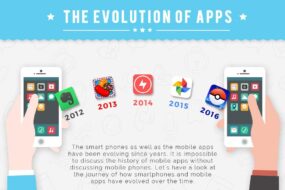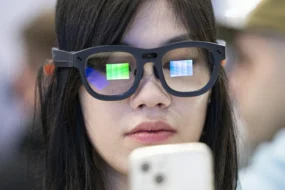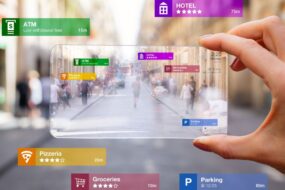
Augmented Reality (AR) is rapidly transforming various industries, and the retail sector is no exception. AR technology blends the physical world with digital content, offering users immersive, interactive experiences. In recent years, AR apps have revolutionized how we shop, enhancing the way customers interact with products, make purchasing decisions, and even visualize items in their own spaces. In this post, we’ll explore how AR apps are reshaping the shopping experience for consumers and businesses alike.
1. Virtual Try-Ons: A More Personalized Shopping Experience
One of the most popular applications of AR in retail is the virtual try-on feature. This technology allows customers to see how products, such as clothing, makeup, glasses, or accessories, will look on them without physically trying them on. With just a smartphone or tablet, shoppers can use AR apps to virtually “try on” different items, helping them visualize how they might look before making a purchase.
For instance, beauty brands like L’Oréal and Sephora offer AR-powered makeup try-ons, allowing users to see how different lipstick shades or eyeshadows look on their faces in real-time. Fashion retailers like ASOS and Zara have also integrated AR features that let customers try on clothes virtually, enhancing convenience and reducing the guesswork that often comes with online shopping.
Benefits:
- Reduces the need for physical trials, saving time and enhancing convenience.
- Increases customer confidence in purchasing decisions.
- Helps prevent returns, as customers have a better idea of how the product will look.
2. Virtual Furniture and Home Decor Shopping
Another area where AR is making a huge impact is in home decor and furniture shopping. AR apps enable customers to visualize furniture, decor items, or even paint colors in their own homes before committing to a purchase. By using their smartphone cameras, consumers can view how a piece of furniture fits into their living space or how a particular color looks on their walls, all through an AR interface.
IKEA’s AR app, IKEA Place, is a great example of this technology in action. The app allows users to place 3D models of furniture pieces in their homes to see how they look and fit in real life. This not only helps in making informed purchasing decisions but also improves customer satisfaction by reducing the uncertainty that often accompanies online furniture shopping.
Benefits:
- Helps customers visualize how products will fit and look in their homes.
- Reduces the likelihood of buyer’s remorse and returns.
- Provides a more interactive and engaging shopping experience.
3. Enhanced Product Information and Interaction
AR can also provide shoppers with more detailed product information and interactive experiences while they are in-store. For example, scanning a product’s barcode or logo with an AR app can bring up additional information such as customer reviews, pricing details, available sizes, or even videos showcasing the product in use.
This application is beneficial for both physical stores and e-commerce platforms. Retailers like Lowe’s and Home Depot have incorporated AR to assist customers in finding the exact product or to demonstrate how products work. For instance, scanning an appliance in-store could provide instructions on installation or maintenance.
Benefits:
- Offers instant access to a wealth of information, improving the decision-making process.
- Provides a more immersive and engaging shopping experience.
- Reduces the need for staff assistance, improving operational efficiency.
4. Gamification and Interactive Shopping
AR is also being used to gamify the shopping experience, creating more engaging and fun ways for customers to interact with brands. Retailers are increasingly using AR to develop interactive games, challenges, or scavenger hunts that encourage customers to engage with their products.
For example, Pokémon Go, although not a traditional retail app, was a huge success in integrating AR with location-based gaming, and many brands have capitalized on this idea. Retailers such as Coca-Cola and Nike have used AR apps to offer unique experiences like treasure hunts or product promotions, blending the digital and physical shopping worlds in a fun and engaging way.
Benefits:
- Increases customer engagement and brand loyalty.
- Creates a memorable and fun shopping experience.
- Encourages repeat visits and interactions with the brand.
5. Bridging the Gap Between Online and In-Store Shopping
AR is bridging the gap between online and in-store shopping experiences. While online shopping offers convenience, one major downside is the inability to physically see and experience products before purchasing. AR solves this problem by allowing online shoppers to interact with products virtually, making them feel more confident in their purchase decisions.
For example, in the fashion industry, brands like Adidas and Nike are experimenting with AR try-ons that allow customers to visualize shoes or clothes on their avatars, combining online convenience with in-store experience elements. Additionally, some stores are offering AR features where users can scan products to view them in 3D, interact with virtual models, and even customize items.
Benefits:
- Provides a more seamless and integrated shopping experience.
- Enhances consumer confidence by allowing them to “test” products virtually.
- Makes online shopping more interactive and engaging.
6. Improved Customer Engagement Through AR Ads
Augmented Reality is also changing the way brands approach advertising. Instead of traditional static ads, retailers are using AR to create interactive and engaging advertisements. These AR ads allow consumers to engage directly with the product or brand in a fun and immersive way.
For example, a consumer could scan a print ad, and the product featured in the ad might come to life in 3D, offering detailed views or additional content like videos or product demonstrations. This kind of interaction increases customer interest and helps brands stand out in a crowded marketplace.
Benefits:
- Creates engaging, memorable brand experiences.
- Improves customer engagement by offering something interactive.
- Increases the likelihood of consumers sharing the AR experience with others.
Conclusion
Augmented Reality is transforming the retail landscape, changing how consumers shop and how brands interact with their customers. From virtual try-ons and interactive product displays to gamified experiences and personalized shopping, AR is making the shopping process more immersive, engaging, and convenient. As AR technology continues to evolve, we can expect even more innovative applications to emerge, further revolutionizing the way we shop in the future. For businesses, adopting AR technology is no longer just a novelty—it’s becoming an essential tool for enhancing customer experience and staying competitive in the retail market.








